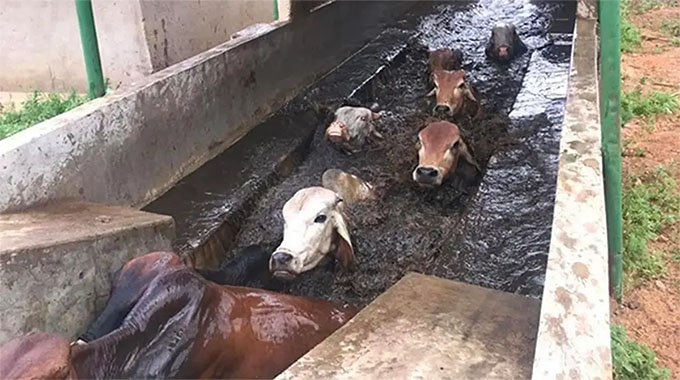Livestock Production Systems transforming smallholder keepers

By Johnson Siamachira
Correspondent
Harare — Climate change is affecting Zimbabwe.
Projections indicate the country will suffer from increasing temperatures, droughts , erratic rainfalls and floods. The agriculture sector will be heavily impacted by this phenomenon as the country is dependent on rainfed agriculture.
Livestock provide income and employment to farmers, agricultural service providers, and other actors involved in the value chain in Zimbabwe.
The country’s livestock production system is characterised by small-scale subsistence farming.
Despite the importance of livestock to rural livelihoods, the sector’s productivity remains very low as a result of farmer behaviour, feed unavailability and cost and poor quality of animals.
In Zimbabwe, small-scale farmers drive the country’s agriculture, which in turn drives the country’s economy. The livelihoods of more than half of the 15 million citizens depend on agriculture but productivity is generally low due to input shortages and limited knowledge of good agricultural practices.
Small-scale farmers also manage 90 per cent of the southern African nation’s 5.5 million cattle. But they face numerous challenges in transitioning to commercial livestock production, which would ultimately increase their incomes, improve the country’s food security, and create jobs.
The Livestock Production Systems in Zimbabwe (LIPS-Zim) project, which started in 2020, aims to improve the country’s livestock production. The four-year European Union-funded project focuses on increasing agricultural productivity in nine districts in Zimbabwe’s agro-ecological regions IV and V. These are semi-arid areas that receive little rainfall and where crop production is nearly impossible without irrigation.
“This project uses a holistic approach that includes herd rationalisation, good animal husbandry practices and critical business development skills,” explains Professor Sikhalazo Dube, the project coordinator, who is also International Livestock Research Institute (ILRI) Southern Africa representative. “Without a basic understanding of good agricultural practices in livestock production, most smallholder farmers cannot sustain livestock herds to move past subsistence livestock farming.”
The LIPS-Zim project is led by ILRI in collaboration with the French Agricultural Research Centre for International Development (CIRAD), the International Maize and Wheat Improvement Centre (CIMMYT), the
University of Zimbabwe’s faculty of veterinary sciences and the Government of Zimbabwe’s Ministry of Lands, Agriculture, Water, Fisheries and Rural Development.
“This is a Government of Zimbabwe project and all the implementing partners are supporting it to ensure the goals and objectives of the project are met,” said Prof Dube.
Climate-smart livestock production practices such as fodder formulation and conservation, water harvesting and manure management have been identified as solutions to improve livestock productivity in the country.
But the adoption rate of these technologies is low due to little understanding of the challenges farmers face by the government, development partners and other key stakeholders, service providers for farmers are inadequate and policy environment is not conducive.
The majority of rural dwellers in Zimbabwe depend on smallholder crop-livestock farming activities based on production of maize, other cereals and legumes along with small and large stock including goats and beef or dairy cattle.
The project has also adopted crop-livestock integration strategies aimed at increasing feed production. To contribute towards LIPS-Zim’s objective for increased feed productivity, project scientists are testing and demonstrating the use of drought tolerant and nutritious maize varieties along with a wide range of leguminous crops, grown mostly as inter-crops.
In addition, the project is using conservation agriculture-based water and soil conservation techniques such as reduced or no-till planting basins and tied ridges interfaced with different mulching options
Tongai Mahachi is a smallholder farmer from Buhera, one of the participating districts. He says of the water harvesting technologies being practiced in his district:
“Making use of the combined benefits of minimum disturbance, crop residue retention and crop rotation, conservation agriculture yields better when compared to conventional agriculture practices after two to five cropping systems.’’
Tongai Mahachi in his soil and warer conservation plot in Buhera district, (Photo: International Livestock Research Institute).
Maureen Javangwe Chauke, a smallholder farmer from Ward 15 of Gwanda district, in Matabeleland South province, was the first female farmer from the district to join the LIPS-Zim project at its inception. Most of the district is semi-arid, and receives little rainfall. Crop production is therefore, not a viable option.
Like many cattle keepers across the country, Chauke, a widow, struggled with the high cost of feed, which can account for up to 70 percent of livestock production costs in Zimbabwe.
Chauke’s was one of the households selected for livestock feed trials using diets based on velvet bean (Mucuna pruriens), hyacinth bean (Lablab purpureus) and cowpea (Vigna unguiculata). The farmers were also trained on how to grow nutrient-dense drought-tolerant forages, produce hay and make home-based feeds. The lablab and mucuna-based feeds, which cost USD0.30 and USD0.33 per kilogram, respectively, have reduced production costs and increased the value of the livestock. The average live weight of her cattle has increased from 400 kg to 520 kg per beast.
International Livestock Research Institute). By rearing better quality livestock, the smallholder farmers in the LIPS-Zim project feed trials have been able to access reliable and lucrative markets outside their localities. Local rural markets are thin and trading in distant urban markets was previously unprofitable because of high transport costs.
“Before joining the feed trials, I sold my beef cattle for USD 350 each but each animal now fetches USD 700. I sell four to 10 cows annually to a commercial buyer who collects them from my farm, so I have also cut down on transportation costs,” says Chauke.
She is ploughing most of her proceeds into her children’s education. At the start of the project, Maureen had 17 cattle. In 2021, she sold 10 to raise university fees for her three children. By the end of last year, she had grown her herd size to 18, ready for the next round of school payments, which add up to USD 6,550 per year.
The investment in education is bearing fruit. One of her children has recently graduated from the University of South Africa and the second will graduate this year. Life is looking up on the home front as well.
“I can purchase sugar, cooking oil, soap and flour in cartons—a development I never dreamt possible. I have even renovated one of our family houses,” Chauke points out.
To support the scaling-up and commercialization of livestock feeding operations, the project procured two sets of two-wheel tractors, hand-operated balers, chopper-grinders, and associated machinery in 2021, for distribution to all the nine districts in 2022.
Animal health management, improved breeds and improved feed are critical to enhancing the resilience of the sector. These can improve veterinary service delivery and disease surveillance, especially for tick-borne diseases that cause high cattle mortality due to a lack of repairs of communally owned dip tanks and infrequent supply of acaricide.
As part of this process of work, LIPS-Zim project has strengthened government laboratories’ capacity for disease detection and surveillance by renovating the Tsetse and Trypanosomosis Control Central Laboratory in Harare and Gwanda and Masvingo provincial laboratories Equipment, reagents, and consumables were also purchased and handed over to the Central and Gwanda laboratories.
By the end of the LIPS-Zim project in December 2023, it is expected to have increased incomes and ensured the food security of 50,000 rural Zimbabweans. The project is also ensuring that farmers have access to reliable markets and buyers, resulting in sustainability of activities. — New Ziana.







Comments